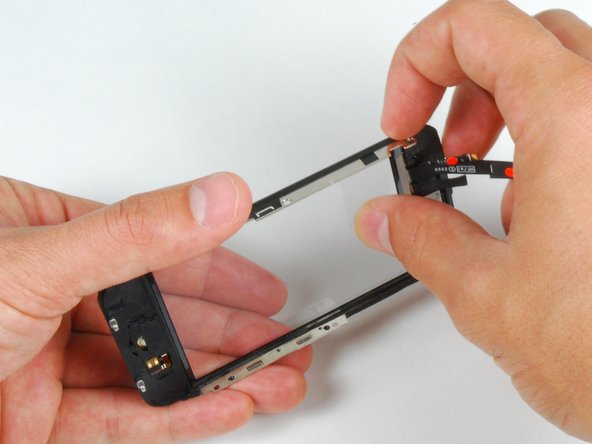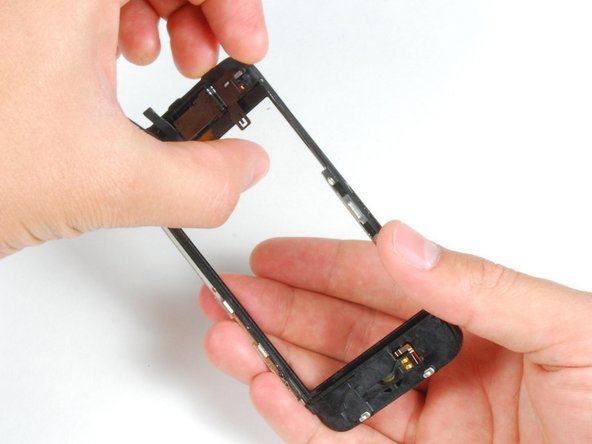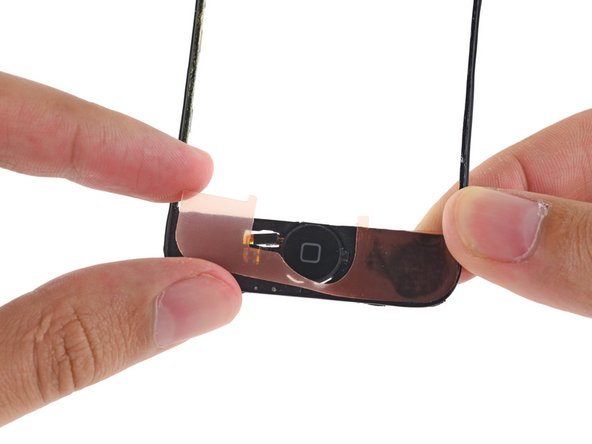Esta versión puede contener ediciones incorrectas. Cambie a la última instantánea verificada.
Qué necesitas
-
-
Si el cristal de la pantalla está agrietado, mantén la rotura contenida y evita que se produzcan daños corporales durante la reparación pegando el cristal con cinta adhesiva.
-
Coloca tiras superpuestas de cinta de embalar transparente sobre la pantalla del iPhone hasta cubrir toda la cara.
-
-
-
Siga sosteniendo el ensamblaje de la pantalla con una mano y use la otra mano y un spudger para desconectar el cable de cinta negro con la etiqueta "1".
-
El cable de cinta "1" está conectado con un conector tipo enchufe. El bloque en el extremo del cable es el enchufe que es simplemente empujado en un zócalo en la placa de circuito. No se utiliza ningún otro mecanismo de bloqueo.
-
-
-
Este paso está sin traducir. Ayuda a traducirlo
-
If the glass has shattered at the top or bottom be especially patient and gentle when removing fragments. In extreme cases you may have to pick off any glass shards that remain glued to the plastics.
-
Using a heat gun or hairdryer, heat the top left area of the touch screen.
-
Use your fingernails to slowly lift up the left corner. The touch screen plastics are held to the touch screen with adhesive. It may take some work to free the corners.
-
Heat and repeat for the right side.
-
-
Este paso está sin traducir. Ayuda a traducirlo
-
Once the top is free, use the heat gun to heat the sides of the touch screen.
-
Use a spudger to free the sides of the touch screen plastics.
-
-
Este paso está sin traducir. Ayuda a traducirlo
-
Heat the bottom corners with the heat gun.
-
Again, use your fingernails to free the corners.
-
Remove the touch screen plastics from the touch screen.
-
-
Este paso está sin traducir. Ayuda a traducirlo
-
In order to adhere the new panel, peel as much of the existing adhesive off of the front panel frame as you can.
-
-
Este paso está sin traducir. Ayuda a traducirlo
-
Place custom fit adhesive strips or double stick tape on the upper area of the front panel plastics.
-
Use the flat end of a spudger to press the adhesive strips to the plastic frame.
-
-
Este paso está sin traducir. Ayuda a traducirlo
-
Place the second adhesive strip or double stick tape on the home button end of the front panel frame.
-
Run the flat end of a spudger over the strip to stick it down and push bubbles out from under the sticker.
-
-
Este paso está sin traducir. Ayuda a traducirlo
-
Using the tip of a spudger to start, peel the adhesive backings off of the strips on the front panel plastic.
-
-
Este paso está sin traducir. Ayuda a traducirlo
-
Peel the protective plastic off of the inside of the front panel glass.
-
-
Este paso está sin traducir. Ayuda a traducirlo
-
Fold the front panel cables down toward the home button recess to get them out of the way.
-
-
Este paso está sin traducir. Ayuda a traducirlo
-
Ensuring that the upper cables are folded clear, align the top of the front glass with the front panel frame.
-
-
Este paso está sin traducir. Ayuda a traducirlo
-
Press the front panel and front panel frame together, ensuring the the home button ends are aligned.
-
-
Este paso está sin traducir. Ayuda a traducirlo
-
Firmly press both ends of the phone to ensure the attachment of the adhesive.
-
Cancelar: No complete esta guía.
479 personas más completaron esta guía.
17 comentarios
Success! It took me quite abit longer than some of those above, but in under 3hrs, it was complete. I am totally satisfied; the only potential problem I've found is that the rubber originally covering the front panel glass and the front panel plastic on the side--i.e., the rubber filling in the gap between the glass and the metal bevel/bezel?sp?--had been partially destroyed during the repair. Now there are spots at the top and bottom where dust could potentially get into the internals more easily. As it is, I opened my phone and it was extremely dusty, so that if it worked well with that kind of dust, I suppose it'll be alright with some more. Besides, now I know how to open it up and clean it! Thanks iFixit! You saved me $140, which is what Apple would have charged to fix my screen.
Cita de Chelsea:
Everything worked except now my home button does not work, help please.
Is the front panel completely snapped into place? I believe there are some contacts on the front panel that have to touch contacts on the inside of the phone for the home button to work.
I have followed all the steps and the phone has turned on, BUT it wont let me slide to open. HELP!!
I'm assuming Sally found the problem to this issue of the phone working but I just had the same problem of no touch screen even though the phone and screen were working otherwise.
Re-open the phone and ensure Cable #2 just isn't attached properly. If this is loose or not correctly connected then the screen will come on but the touch screen won't work.
andrew -















































